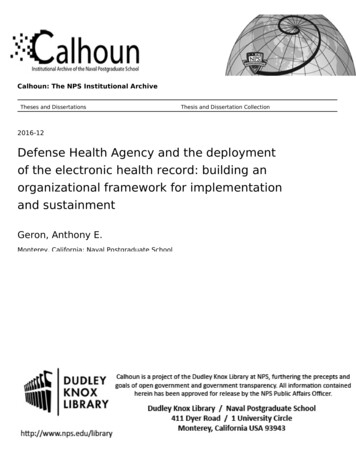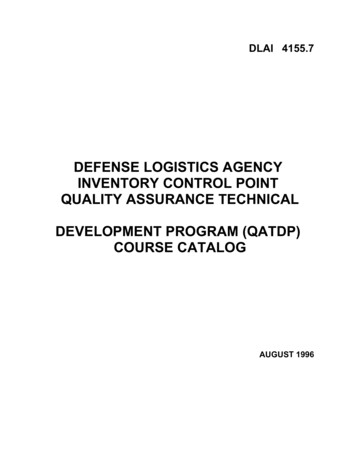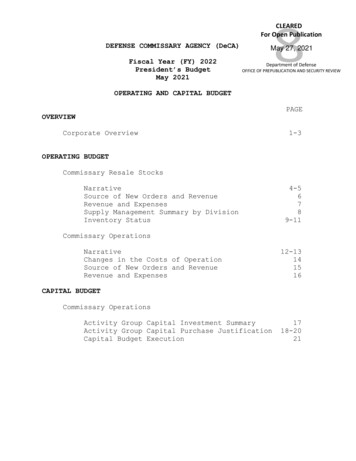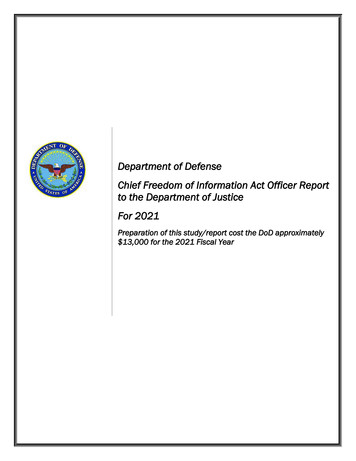
Transcription
Calhoun: The NPS Institutional ArchiveTheses and DissertationsThesis and Dissertation Collection2016-12Defense Health Agency and the deploymentof the electronic health record: building anorganizational framework for implementationand sustainmentGeron, Anthony E.Monterey, California: Naval Postgraduate Schoolhttp://hdl.handle.net/10945/51700
NAVALPOSTGRADUATESCHOOLMONTEREY, CALIFORNIATHESISDEFENSE HEALTH AGENCY AND THE DEPLOYMENTOF THE ELECTRONIC HEALTH RECORD: BUILDINGAN ORGANIZATIONAL FRAMEWORK FORIMPLEMENTATION AND SUSTAINMENTbyAnthony E. GeronYuri N. NybergDecember 2016Thesis Advisor:Second Reader:Glenn CookRichard BerginApproved for public release. Distribution is unlimited.
THIS PAGE INTENTIONALLY LEFT BLANK
Form Approved OMBNo. 0704-0188REPORT DOCUMENTATION PAGEPublic reporting burden for this collection of information is estimated to average 1 hour per response, including the time for reviewinginstruction, searching existing data sources, gathering and maintaining the data needed, and completing and reviewing the collectionof information. Send comments regarding this burden estimate or any other aspect of this collection of information, includingsuggestions for reducing this burden, to Washington headquarters Services, Directorate for Information Operations and Reports, 1215Jefferson Davis Highway, Suite 1204, Arlington, VA 22202-4302, and to the Office of Management and Budget, PaperworkReduction Project (0704-0188) Washington DC 20503.1. AGENCY USE ONLY2. REPORT DATE3. REPORT TYPE AND DATES COVEREDDecember 2016Master’s thesis(Leave blank)4. TITLE AND SUBTITLE5. FUNDING NUMBERSDEFENSE HEALTH AGENCY AND THE DEPLOYMENT OF THEELECTRONIC HEALTH RECORD: BUILDING AN ORGANIZATIONALFRAMEWORK FOR IMPLEMENTATION AND SUSTAINMENT6. AUTHOR(S) Anthony E. Geron and Yuri N. Nyberg7. PERFORMING ORGANIZATION NAME(S) AND ADDRESS(ES)Naval Postgraduate SchoolMonterey, CA 93943-50009. SPONSORING /MONITORING AGENCY NAME(S) ANDADDRESS(ES)N/A8. PERFORMINGORGANIZATION REPORTNUMBER10. SPONSORING /MONITORING AGENCYREPORT NUMBER11. SUPPLEMENTARY NOTES The views expressed in this thesis are those of the author and do not reflect theofficial policy or position of the Department of Defense or the U.S. Government. IRB protocol number N/A .12a. DISTRIBUTION / AVAILABILITY STATEMENTApproved for public release. Distribution is unlimited.13. ABSTRACT (maximum 200 words)12b. DISTRIBUTION CODEAThis thesis explores the Defense Health Agency’s (DHA) implementation and sustainment of thenewly acquired electronic health record (EHR). The Military Health System (MHS) is utilizing adisjointed taxonomy of patient health record systems to deliver health services that are cumbersome toboth the end users and the health information technology specialists in its use and delivery. The acquisitionof the new commercial off-the-shelf EHR in 2016 from Cerner-Leidos-Accenture offers an enterprisesolution to the MHS. This advanced IT solution requires detailed, deliberate implementation anddeployment planning by the DHA, which will result in the effective, efficient, and economical delivery ofhealthcare services to Department of Defense personnel. Utilizing a case study approach, the authorsconducted interviews at two sites within the DHA EHR deployment footprint and correlated results withthe application and research of Kates and Galbraith’s star model. The authors conclude that withappropriate change management efforts, communication of strategy and structure, measurement of metrics,and investment in people, the DHA has the ability to implement MHS GENESIS within reasonableschedule parameters and achieve equitable sustainment.14. SUBJECT TERMSDefense Health Agency, Department of Defense, military treatment facility, Military HealthSystem, healthcare, health information technology, information management, informationsystem, chief information officer, electronic health record, enterprise resource planning,strategy, structure, process, rewards, people, MHS GENESIS15. NUMBER OFPAGES9116. PRICE CODE17. SECURITYCLASSIFICATION OFREPORTUnclassified20. LIMITATIONOF ABSTRACT18. SECURITYCLASSIFICATION OF THISPAGEUnclassifiedNSN 7540-01-280-550019. SECURITYCLASSIFICATIONOF ABSTRACTUnclassifiedUUStandard form 298 (Rev. 2-89)Prescribed by ANSI Std. 239-18i
THIS PAGE INTENTIONALLY LEFT BLANKii
Approved for public release. Distribution is unlimited.DEFENSE HEALTH AGENCY AND THE DEPLOYMENT OF THEELECTRONIC HEALTH RECORD: BUILDING AN ORGANIZATIONALFRAMEWORK FOR IMPLEMENTATION AND SUSTAINMENTAnthony E. GeronLieutenant, United States NavyB.S., Trident University, 2009M.S., Trident University, 2012Yuri N. NybergLieutenant, United States NavyB.A., Washington State University, 2008M.P.A., Eastern Washington University, 2010Submitted in partial fulfillment of therequirements for the degree ofMASTER OF SCIENCE IN NETWORK OPERATIONS AND TECHNOLOGYfrom theNAVAL POSTGRADUATE SCHOOLDecember 2016Approved by:Glenn CookThesis AdvisorRichard BerginSecond ReaderDan BogerChair, Information Sciences Departmentiii
THIS PAGE INTENTIONALLY LEFT BLANKiv
ABSTRACTThis thesis explores the Defense Health Agency’s (DHA) implementation andsustainment of the newly acquired electronic health record (EHR). The Military HealthSystem (MHS) is utilizing a disjointed taxonomy of patient health record systems todeliver health services that are cumbersome to both the end users and the healthinformation technology specialists in its use and delivery. The acquisition of the newcommercial off-the-shelf EHR in 2016 from Cerner-Leidos-Accenture offers anenterprise solution to the MHS. This advanced IT solution requires detailed, deliberateimplementation and deployment planning by the DHA, which will result in the effective,efficient, and economical delivery of healthcare services to Department of Defensepersonnel. Utilizing a case study approach, the authors conducted interviews at two siteswithin the DHA EHR deployment footprint and correlated results with the applicationand research of Kates and Galbraith’s star model. The authors conclude that withappropriate change management efforts, communication of strategy and structure,measurement of metrics, and investment in people, the DHA has the ability to implementMHS GENESIS within reasonable schedule parameters and achieve equitablesustainment.v
THIS PAGE INTENTIONALLY LEFT BLANKvi
TABLE OF CONTENTSI.INTRODUCTION.1A.BACKGROUND .1B.PROBLEM STATEMENT .2C.PURPOSE STATEMENT .2D.RESEARCH OBJECTIVE .3E.RESEARCH QUESTIONS .5II.LITERATURE REVIEW .7A.ELECTRONIC HEALTH RECORD .7B.STRATEGY—DIRECTION .11C.STRUCTURE—POWER .14D.PROCESSES—INFORMATION .17E.REWARDS—MOTIVATION .20F.PEOPLE—SKILLSETS AND MINDSETS .22G.SUMMARY OF LITERATURE REVIEW.24III.METHODOLOGY .27A.RESEARCH DESIGN .271.Philosophy.272.Qualitative Strategy .283.Data Gathering Methods .28B.RESEARCH APPROACH .30IV.ANALYSIS .33A.DATA .331.Textual Analysis .33a.Strategy .34b.Structure .37c.Processes.39d.Rewards .40e.People .412.Site Interviews .41a.DHA Site 1, Navy Medicine West Case .44b.DHA Site 2, Navy Medicine West Case .45c.Comparison of Cases .46vii
B.V.INTERPRETATION OF THE DATA .461.Textual Analysis .472.Interview Analysis.49FINDINGS, CONCLUSION, AND RECOMMENDATIONS .53A.FINDINGS .53B.CONCLUSION .55C.RECOMMENDATIONS .561.Decision Framework .572.Goals, Measures, and Milestones.583.Project Management .584.Change Management .59APPENDIX A.INTERVIEW TRANSCRIPTS.63A.INTERVIEW TRANSCRIPT SITE 1.63B.INTERVIEW TRANSCRIPT SITE 2.65APPENDIX B.MHS GENESIS HANDOUT.69LIST OF REFERENCES .71INITIAL DISTRIBUTION LIST .75viii
LIST OF FIGURESFigure 1.Star Model. Source: Kates & Galbraith (2007, p. 3). .3Figure 2.EHR Adoption in the United States. Source: Health IT Dashboard(n.d.). .9Figure 3.Percent of Hospitals with Electronic Health Records and Health IT.Source: Health IT Dashboard (n.d.). .10Figure 4.Breaches of Protected Health Information. Source: Health ITDashboard (n.d.).11Figure 5.Four Operating Model Choices. Source: Ross (2005). .15Figure 6.Lateral Connections Continuum. Source: Kates & Galbraith (2007). .18Figure 7.DHA Health IT City Plan 2016. Source: Defense Health Agency(n.d.). .35Figure 8.DHA EHR Deployment Strategy in the PNW. Source: DefenseHealth Management Systems (n.d.). .36Figure 9.DHA EHR Guiding Principles. Source: Defense Health ManagementSystems (n.d.).37Figure 10.Defense Health Agency Organizational Structure. Source: DefenseHealth Agency (n.d.). .39Figure 11.MHS GENESIS Handout. Source: Defense Health ManagementSystems (n.d.).69ix
THIS PAGE INTENTIONALLY LEFT BLANKx
LIST OF TABLESTable 1.Star Model Elements Comparison within Interviews .43xi
THIS PAGE INTENTIONALLY LEFT BLANKxii
LIST OF ACRONYMS AND ABBREVIATIONSCFOchief financial officerCIOchief information officerCSFcritical success factorsDODDepartment of DefenseDHADefense Health AgencyDHMSDefense Health Management SystemEHRelectronic health recordERPEnterprise Resource Planning (System)GAOGovernment Accountability OfficeHIPPAHealth Insurance Portability and Accountability ActHIThealth information technologyIAOinformation assurance officerIMinformation managementISinformation systemITinformation technologyKPKaiser PermanenteMHSMilitary Health SystemMTFmilitary treatment facilityNMWNavy Medicine WestPEOprogram executive officerPNWPacific NorthwestPOCpoint of contactxiii
THIS PAGE INTENTIONALLY LEFT BLANKxiv
I.A.INTRODUCTIONBACKGROUNDThe United States Congress recently designated an agency to create, manage, andlead the Military Health System’s (MHS) Health Information Technology (HIT)Enterprise (Nyberg & Sezgin, 2016). The newly formed Defense Health Agency (DHA)was created in 2013, and it is tasked to serve several significant purposes. They are thefollowing: manage the information technology enterprise across the Military HealthSystem (MHS), integrate the component services (Army, Air Force, Navy, and MarineCorps) HIT systems and applications, and deploy the new acquired electronic healthrecord (EHR) (Nyberg & Sezgin, 2016). This includes implementing a shared servicesenvironment that creates a cost savings in HIT (Government Accountability Office[GAO], 2015). The agency has an enormous responsibility to the military servicecomponents and the 220,000 medical personnel, 9.5 million beneficiaries, and the newlyformed HIT Enterprise (GAO, 2015; Defense Health Agency, n.d.).The DHA’s strategy, organizational structure, and business processes introduceorganizational challenges to the promulgation of change within the newly appointedagency and the component services (Nyberg & Sezgin, 2016). In July 2015, the DHAawarded Cerner-Leidos-Accenture an 11 billion, 18-year EHR contract for the MHS,which includes all service components (Sullivan, 2015). The proposed deployment datewill commence in January 2017 across the MHS and reach over 1,000 medical treatmentfacilities (MTF) by the year 2020 (Sullivan, 2015). The issues that will accompany itsdeployment across the enterprise will surely be met with a multitude of organizationalbarriers regarding the implementation and deployment of the EHR and related systems.These challenges will require a particular business finesse and leaders with a uniqueacumen to ensure the successful deployment and implementation of the EHR systemoccurs across the MHS Enterprise.1
B.PROBLEM STATEMENTThe DHA needs to effectively deploy and implement the EHR across the MHSenterprise to achieve its mission, which is to provide and deliver high quality, patientcentered (or focused) care (Nyberg & Sezgin, 2016). The MHS is utilizing a disjointedtaxonomy of patient health record systems to deliver health services that are cumbersometo both the end users and the health information technology specialists in its use anddelivery. The acquisition of the new commercial off-the-shelf EHR in 2016 from CernerLeidos-Accenture offers an enterprise solution to the MHS (Nyberg & Sezgin, 2016).This advanced (information technology) IT solution will require detailed, deliberateimplementation and deployment planning by the DHA to result in the effective, efficient,and economical delivery of healthcare services to Department of Defense personnel(Nyberg & Sezgin, 2016). It is imperative that the DHA incorporate a strategy andorganizational structure that supports viable and effective business processes, includesskilled personnel who utilize the EHR, and includes a system of rewards for thosepersonnel who support the EHR within the MHS.C.PURPOSE STATEMENTThe purpose of this thesis is to examine the potential organizational barriers andchallenges with the implementation of the new EHR, which is known as MHS GENESIS(see Appendix B for additional information related to MHS GENESIS). Specifically, theauthors evaluated and recommended a viable implementation and sustainment strategyfor the DHA. The strategy addresses the barriers effecting the implementation andsustainment of MHS GENESIS. Strategy development includes the evaluation of tationandsustainment,implementing business processes, developing skilled IT personnel, and creating a systemof rewards for IT personnel. DHA may incur additional delays with implementation ofthe EHR due to service component cultures and related policies as well as regulations thatenforce the cultural barriers (and associated challenges). The absence of an enterprisestrategy to address these challenges validates the need for DHA to design a defined,2
methodical strategic approach to the EHR deployment across the MHS. This necessitatesthe evaluation of DHA’s strategic goals and strategic development.The writers accomplish these thesis goals through the application of Galbraith’sorganizational efficiency star model (see Figure 1) to circumvent the barriers andchallenges across MHS HIT enterprise to achieve DHA’s strategic goals and objectives(Nyberg & Sezgin, 2016).Figure 1. Star Model. Source: Kates & Galbraith (2007, p. 3).D.RESEARCH OBJECTIVEThe objective of this research is to evaluate the deployment and implementationof the DHAs EHR, MHS GENESIS utilizing an organizational efficiency model. The starmodel is a framework for organizational design and consists of policies that arecontrolled by management and it may influence employee behavior (Kates & Galbraith,2007). The organizational design policies fall into five categories or five points of a star.The design policies, or star points, are the following: strategy, structure, processes,rewards, and people. Strategy determines the direction of an organization, structuredetermines the location of decision-making power, and processes are related to the flowof information (Kates & Galbraith, 2007). The reward point of the star is reward systems3
or policies that motivate personnel within an organization to perform and achieveorganizational goals, and the people element of the model is related to human resourcepolicies, which define and influence employee’s skillsets and mindsets (Kates &Galbraith, 2007).Kates and Galbraith (2007) challenge the traditional notion of matrixedorganizations and imply that these organizations over emphasize the strategy andstructural elements of the star model. In addition, they spend little effort on policiesrelated to processes (business), rewards (motivation), and people (skillsets and mindsets).The star model is the foundational element of the thesis and evaluating the challenges andbarriers of the EHR deployment across the MHS.There are a multitude of researchers and healthcare specialists who have studied,evaluated, and researched EHR implementation and sustainment issues across healthcareorganizations, and this research has a recurring theme. It is primarily focused on theinclusion of employees in the EHR adoption and deployment stages, EHR training,organizational strategy, and business processes. There is additional research on leadershipissues and how organizational structure and leadership buy-in determines the final orsuccessful outcome of an EHR deployment and adoption. The overarching theme is thegreat importance of people, or employees, and business processes within healthcareorganizations in the research. These factors may determine the successful implementationand sustainment of an IT/information management (IM) platform such as an EHR.Additionally, there is little information on rewards or motivation systems anddevelopment of the skillsets of employees who utilize EHRs, and there is a lack ofdetailed information regarding EHR adoption and deployment strategy in anorganization. These are possibly the most critical elements in the deployment andimplementation of an EHR system. The lack of research on rewards within healthcareorganizations, developing employee skillsets, and integrating and applying the priorresearch with the five points of Galbraith’s star model as well as the development of anorganization’s overarching strategy leading up to the implementation of an EHR are thedriving elements of this thesis.4
It is the goal of the authors of this thesis to compile data from research journals,peer-review periodicals, and available organizational structure information (DHA privateand public facing websites) to answer the research questions that are presented in the nextsection. This includes contributing to the field of healthcare, healthcare IT, and theDepartment of Defense (DOD) with new data and research from the authors. This newinformation, or reshaped information, may assist the DOD, DHA, and other healthcareorganizations in the successful implementation of HIT systems and applications across alarge enterprise in the future.E.RESEARCH QUESTIONSThe following are three research questions posed by the authors of this thesis. Thequestions are explored and examined throughout this writing. Furthermore, the reader isexposed to and provided ample, highly informative, and up-to-date information regardingthe identified topic area throughout the five chapters to make both an informed andaccurate determination on each question posed.1.How could an enterprise strategy contribute to the successfulimplementation of a large-scale enterprise resource planning (ERP) systemsuch as the newly acquired EHR?2.How could the gaps, or absence, in business processes, personneldevelopment, and rewards systems prevent the successful implementationof an EHR?3.How can DHA address the challenges associated with vertical and lateralprocesses to attain sustainment operations?5
THIS PAGE INTENTIONALLY LEFT BLANK6
II.LITERATURE REVIEWCreswell (2009) stated that a literature review serves several purposes, and “itshares with the reader the results of other studies that are closely related to the one beingundertaken” (p. 25). Additionally, the literature review “provides a framework forestablishing the importance of the studies as well as a benchmark for comparing theresults with other findings” (Creswell, 2009, p. 25). The authors of this literature reviewevaluated numerous peer-reviewed journals, research studies, and other publicationsrelated to the implementation and sustainment of electronic health records (EHRs) inhealthcare organizations.Specifically, the authors explored and examined five significant elements basedupon the Galbraith star model for decision making, which enable large healthcareenterprises to construct an organizational framework for EHR systems. The five elementsare organizational strategy (direction), structure (power), processes (information),rewards (motivation), and people (skillsets and mindsets). Furthermore, the authorsprovide readers with an increased awareness of the ongoing dialogue in the literature, andthe current issues healthcare enterprises are confronted with regarding implementationand sustainment of an EHR system.A.ELECTRONIC HEALTH RECORDSeveral studies explored EHR systems and defined the purpose of the patient-based IT systems. The EHR and associated systems are a means for physicians and otherclinical personnel, or medical providers, to manage patient care (Robichau, 2014). TheEHR contains an electronic set of patient data associated with an individual patient andaccess spans across multiple healthcare providers (Robichau, 2014). EHRs are dynamicin nature and allow clinical personnel to utilize capabilities such as online access topatient charts and information (e.g., medical and family history, medication usage,radiological imaging), physician order entry, and other online resources available toindividual patients. The EHR, or medical record, is the keystone of healthcare in theinpatient and outpatient settings, including pre-hospital and emergency medicine7
environments (Bircher, 2010). Bircher (2010) stated that EHRs reduce patient risks (e.g.,death or serious bodily harm) by openly sharing patient information in an electronicrepository, and the EHR acts as a decision support system reminding medical providers toconduct additional tests, provide medications to patients, or notify providers of diagnosticcriteria. This includes issuing an emergency alarm in the event a patient may be presentedin a dangerous situation (Bircher, 2010). Moreover, EHRs and associated systems are anindispensable tool to clinical personnel in the fast paced, information saturatedenvironments observed in the healthcare settings.Gartee (2011) stated, “The idea of computerizing patients’ medical records hasbeen around for more than 30 years, but only in the past decade has it become widelyadopted” (p. 1). In the time prior, the EHR, patients’ medical records and relatedinformation was hand-written, or typed, and stored in paper-based file systems (Gartee,2011). The use of patient record systems began early in the twentieth century at the MayoClinic in Rochester, Minnesota. Here, paper-based records were kept in file cabinetswithin each clinical area, and the records were organized in a manner similar to the publiclibrary system (Hobbs, 2016). The issue with these aged systems is that patient recordswere stored and located in different clinical areas within a hospital. One clinical area(e.g., cardiology) would be unable to share or display patient health information toanother clinical area (e.g., orthopedics), which helps create an environment with minimal(at best) collaboration or information sharing (Hobbs, 2016). A physician would not beaware of or able to retrieve a patients’ medical history, medication use, or overall healthstatus, thus creating a dangerous and life-threatening environment for patients undergoingcare. A technological solution emerged—the EHR—out of the dangerous events andrelated conditions patients were exposed to under the paper-based record system. Today,the EHR is a vital component of hospital and information system management within ahealthcare system, but it may be minimally realized by healthcare systems(Bircher, 2010).Although the EHR is a relatively new technology and has issues in the healthcaresetting, it offers a technological solution to assist physicians, nurses, and other healthcareproviders in accomplishing the required daily task of treating and caring for patients with8
more ease than observed in the past. The EHR adoption and uptake was relatively slowwith only nine percent of healthcare systems adopting EHR technologies in 2009(see Figure 2) (Hobbs, 2016). By 2015, more than 90 percent of healthcare systems hadacquired certified EHR technology and related systems (see Figures 2 and 3) (Health ITDashboard, n.d.).Figure 2. EHR Adoption in the United States. Source:Health IT Dashboard (n.d.).9
Figure 3. Percent of Hospitals with Electronic Health Records and Health IT.Source: Health IT Dashboard (n.d.).The increased adoption rate observed in Figures 2 and 3 is attributed to the 2009federal mandate prompting EHR adoption, and the relative time it took U.S. healthcaresystems to realize the potential and measurable benefits of EHRs. Several EHR benefitsare: increased patient safety, elimination of or reduced medical errors, reduced healthcarecosts for facilities, and the ability to create metrics to measure performance (Haugen &Woodside, 2010).Although, EHRs are a revolution in the medical and IT fields, they do come withseveral drawbacks. The EHR systems are expensive to implement, poorly designed EHRsystems are cumbersome to end-users, and the records expose protected patient healthinformation on computer networks connected to the Internet. This includes breaches ofpatient record information (see Figure 4) and other information security issues thatviolates federal statutes like the Health Insurance Portability and Accountability Act10
(HIPAA). These issues will arise with the advent of new and emerging e-healthtechnologies and will require both government and non-government hospital systems toaddress them in their strategic and operational plans. Nonetheless, EHR systems are avery effective and efficient means to delivering high quality, patient focused care topatients in need of medical treatment in any healthcare setting, and they are a necessity intoday’s dynamic, fast-paced, and IT-based healthcare environment.Figure 4. Breaches of Protected Health Information. Source:Health IT Dashboard (n.d.).B.STRATEGY—DIRECTIONKates and Galbraith (2007) stated an organization’s success is dependent upon itsstrategy—its direction. Strategy is a derivative of several factors. The first factor issenior leaderships understanding of four business areas: competitors, suppliers, customerbases, and new technologies. This understanding, coupled with an awareness of anorganizations strengths and the relationship it has to these business areas, is paramount in11
the formulation of an organizational strategy. The second factor is attainingdistinguishable, internal organizational capabilities (Kates & Galbraith,
PRICE CODE 17. SECURITY CLASSIFICATION OF REPORT. Unclassified . 18. SECURITY CLASSIFICATION OF THIS PAGE . Unclassified . 19. SECURITY CLASSIFICATION OF ABSTRACT . Unclassified . 20. LIMITATION OF ABSTRACT . UU . NSN 7540-01-280-5500 Standard form 298 (Rev. 2-89) Prescribed by ANSI Std. 239-18 . ii THIS PAGE INTENTIONALLY LEFT BLANK . iii . Approved for public release. Distribution is .











